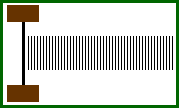Longitudinal Waves and Guitar Strings
A sound wave is produced by a vibrating object. As a guitar string vibrates, it sets surrounding air molecules into vibrational motion. The frequency at which these air molecules vibrate is equal to the frequency of vibration of the guitar string. The back and forth vibrations of the surrounding air molecules creates a pressure wave which travels outward from its source. This pressure wave consists of compressions and rarefactions. The compressions are regions of high pressure, where the air molecules are compressed into a small region of space. The rarefactions are regions of low pressure, where the air molecules are spread apart. This alternating pattern of compressions and rarefactions is known as a sound wave.

In solids, sound can exist as either a longitudinal or a transverse wave. But in mediums which are fluid (e.g., gases and liquids), sound waves can only be longitudinal. The animation above depicts a sound wave as a longitudinal wave. In a longitudinal wave, particles of the medium vibrate back and forth in a direction which is parallel (and anti-parallel) to the direction of energy transport. In the animation above, the energy is shown traveling outward from the guitar string - from left to right. A careful inspection of the particles of the medium (represented by lines) in the animation above reveal that the particles of the medium are displaced rightward and then move back leftward to their original position. There is no net displacement of the air molecules. The molecules of air are only temporarily disturbed from their rest position; they always return to their original position. In this sense, a sound wave (like any wave) is a phenomenon which transports energy from one location to another without transporting matter.
A guitar string vibrating by itself does not produce a very loud sound. The string itself disturbs very little air since its small surface area makes very little contact with surrounding air molecules. However, if the guitar string is attached to a larger object, such as a wooden sound box, then more air is disturbed. The guitar string forces the sound box to begin vibrating at the same frequency as the string. The sound box in turn forces surrounding air molecules into vibrational motion. Because of the large surface area of the sound box, more air molecules are set into vibrational motion. This produces a more audible sound.
For more information on physical descriptions of waves, visit The Physics Classroom Tutorial. Detailed information is available there on the following topics:
What is a Wave?
Sound as a Mechanical Wave
Sound as a Longitudinal Wave
Sound as a Pressure Wave
Pitch and Frequency
Natural Frequency
Forced Vibration and Resonance